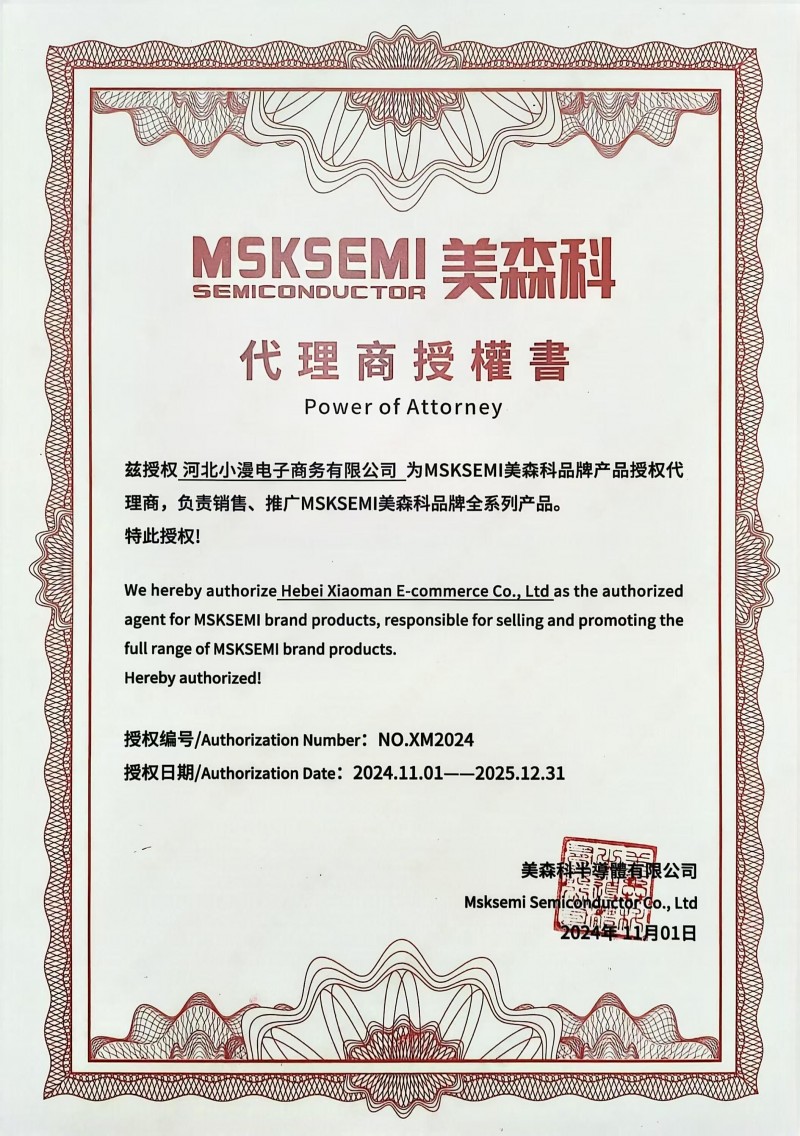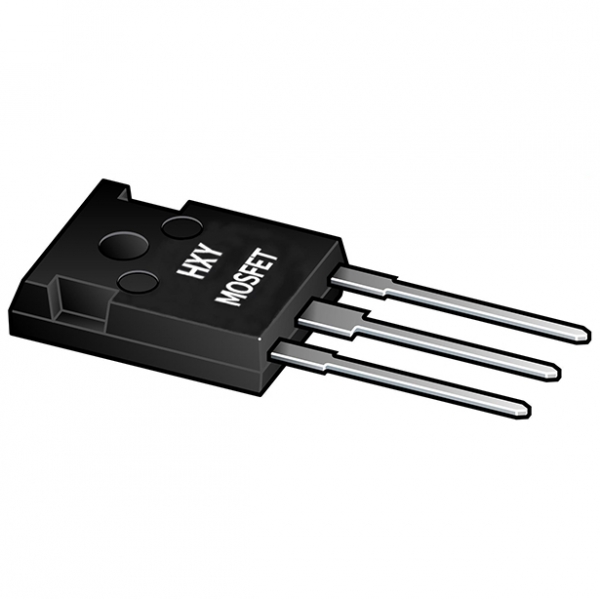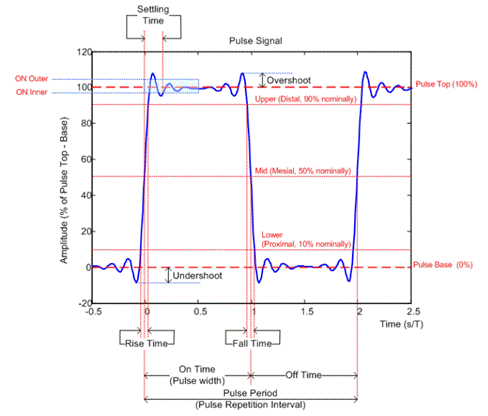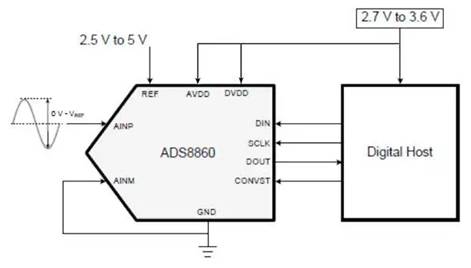文章转自ADI官网,版权归属原作者一切
[Ed. The first part of Niku’s talk can be found at D-Day.]
“This next study will show some results comparing the relative effects of mismatches and noise. Such comparisons can never be precise, for reasons I gave earlier. Not only are mismatches just interesting cases; the onset of strong oscillations—the start-up trajectory—also depends on such controllable factors as the rise-rate of the tail current, IT; the overdrive beyond the critical value, ICRIT; and the load resistance, determining the tank’s effective Q. once these have been chosen, we can compare start-up-times, defined as the time from when the tail current crosses ICRIT to the time the oscillations reach 90% of their final amplitude.
“I’m sure all of you appreciate that frequently, the potency of simulation in gaining insights does not necessitate the use of accurate parameter values, or reliable process statistics, such as are essential in predicting the performance of a production microsym. Rich insights are to be gained from pursuing a well-planned set of comparative studies using relative values that are just as valuable as the /confirm/iation of an original design using absolute parameter values…”
Dr. Leif raised his hand politely. Niku caught the gesture and invited his comments. “Yes, sir? Do you have a little song for us?” she teased.
“Perhaps we ought to say ‘far more valuable’, since we should never forget than learning is as much a part of an engineer’s job as getting new products to market—and this is as important for our Fusers as for Originators. We must always set aside time in our busy lives to think about those Fundaments, and ceaselessly ask ourselves those vital questions: ‘What If?’, ‘How about?’, ‘Why does that Happen?’. You need to be acutely aware that, while your latest, thoroughly robust, high-yielding and trend-setting product, which you have managed to get to market in a competitive time-frame, and yet meets every one of its highly challenging performance specifications and goes on to make us all fabulously rich…” (Leif grins as the audience groans, and he takes a brief sip from his water-glass) “…while all that is very important, it is the new insights that you gained throughout the experience, as well as from the time you put into facing up to independent, self-assigned challenges—of the sort that Niku is urging you to undertake—they will be the foundation-stones of your career. New product development frequently requires the use of several distinctively clever ideas. But that is a one-time event. On the other hand, the new insights that opened to you, during the experience, become the precious gems you’ll add to your own unique treasure trove of tools. These diamond-hard gems of insight will never be far from you, waiting in your sub-conscious to illuminate and inform the creative work of a long and productive career. I …”
Leif stopped abruptly, as suddenly as he had apparently felt the need to make these interlineal observations. Returning to his front-row seat, he seemed uncharacteristically self-conscious. What next thought that he decided to suppress was in his mind?
“War das eu’r lied?” Niku again teased, with a little quote from Die Meistersinger—as asked by Hans Sachs, the humble cobbler, of Sextus Bessemer, the town clerk of 16th-century Nuremberg who was attempting to serenade the heroine Eva. From the chats they frequently enjoyed over at Galaxybux, Niku knew that Leif would be in on the joke, and both smiled together at its poignant appropriateness. But the bulk of the audience was perplexed by this unfamiliar four-word exchange, yet increasingly aware of the unusual rapport and the spirited give-and-take between these two. Had they been more informed about widowed Hans Sachs and the young Eva, the parallel would have been evident.
Breaking eye-contact, and seeming to suddenly remember she was in the middle of a lecture, Niku blushed deeply and visibly for the second time in an hour.
“Thank you, Dr. Leif. So…ah, back to our little friend, Oscar. A few minutes ago…” (Or was it a week? Or a century?) “I showed that its internal noise—and the enormous noise-amplification factor—reduce this time to just a few cycles. So, comparisons of start-up time are much too close to be of any use as a source of insight. In fact, for even tiny amounts of [stochastic] noise, the very notion of a start-up trajectory becomes moot. Rather, the modulation envelope during start-up, which can be seen in this slide” (Micha-2, which had remained frozen on the screen) “is determined by the particular L, C, and R of the tank.
“However, to complicate matters further, the effective loading of this tank, embedded in the active circuit—the in-situ value—is not the value that is conventionally deduced from measurements of the tank alone—the ex-situ value. And here, I’m not referring to any incidental, parasitic effects, for example, as caused by the shunt loading imposed by the incremental output resistance of the differential pair. In fact, as I believe I mentioned earlier, to remove all such complicating factors, the transistors are assigned Early voltages (VAF and VAR) of 109 volts, and the classical dc beta-modeling factors (BF and BR) are similarly 109.
“This is not as fanciful as it might at first seem, because the core properties of the BJT do not depend on these parameters having moderately low values. Indeed, they represent defects—rather than assets—of the transistor. We long ago gave up thinking of the BJT as a current-controlled current source (CCCS); rather, just like field-effect devices, they are more properly viewed as voltage-controlled current-sources (VCCS). The finite output resistance of a VCCS never did anything useful for it; neither does the base current of a BJT, unless you were foolish enough to actually depend on the need for some finite base current.
“Likewise, the depletion capacitances (CJE, CJC, CJS) are just useless baggage, as are the ohmic resistances (RE, RB-RBC, RC), and should not be depended on for any specific circuit behavior. Between them, they only increase the inertia of a circuit, and the ohmic parts contribute thermal noise. They are defects of a BJT. By the way, don’t confuse the diffusion capacitance with those parasitics. It is a direct measure of the base charge needed to establish a given collector current.
“This perspective—and the practice of stripping the BJT model of all non-useful attributes during preliminary investigations of new and unfamiliar topologies—is called ‘Foundation Design’ by Dr. Leif. When every nuance of the cell has been thoroughly understood and accounted for, using what he calls this ‘Level 0’ model, it is permissible to move forward to a ‘Level 1’ model, which, for example, might first add in more realistic values of the dc betas and Early voltages, the consequences of quasistatic depletion-layer modulation by the terminal voltages…”
Some in the audience, listening to what was beginning to sound more like philosophy, were manifesting spaced-out expressions; but most were working hard to follow the convoluted contour of Niku’s thinking. Leif again wanted to comment and again was polite enough to signify this by raising his hand.
“Dr. Leif?”
“Ah, well, let’s see now. First, if you’ll forgive me Niku, you’re running a little short on time, and I know you have some really interesting discoveries to share with us, about Oscar. I suspect you didn’t plan to digress so deeply into these peripheral ideas at the expense of the main theme, did you? Secondly, neither the term ‘Foundation Design’ nor its principles are mine, although I admit I am a passionate advocate of them. They go way back to the last century, and the lectures given by a long-departed ADI Fellow, of whom we hear very little these days. When I get back to my office, I’ll issue a cy-mail, and include a reference to his lectures, for the engineering community. Okay. That’s it.”
“Oh, yes; now I recall, you did tell me that Foundation Design came from a long time back. I’m sorry I got that mixed up. And you’re right: I got a bit carried away with some incidental ideas. I was about to explain that another approach to tracing the start-up trajectory is to disable the modeling, and run the simulations in the old SPICE-like mode, when they didn’t model noise as a time-process. Then, using a variety of representative mismatches we can simply observe how the start-up times compare to the noise-driven case.
“In fact, now that we have seen how very short this delay can be, provided that noise mechanisms are fully modeled, we need to extract some other insights from these studies. To be candid, that was the only reason for starting down this path. I was pretty sure from the outset that noise had to be the driver—in both senses: ‘was bound to be’ and ‘had better be’, and that in all cases where this wasn’t so it would be due to unplanned mismatches. But never due to glitches! Any oscillator that needs to be started by such gross influences is, as a matter of practical definition, a poor design, since this very sensitivity is almost bound to degrade the phase noise after it reaches its periodic steady state.”
“Dr. Yeng?” It was a rather mature lady’s voice from two rows back. “That’s not quite true. There are times when one wishes to preserve a very high effective Q in a different class of oscillator, which would indeed eventually start up because of noise, and in a certain sense right away, but would reach its cyclostationary state only after perhaps tens of thousands of cycle; whereas its services are needed immediately following a logic edge that defines t=zero. So one needs to introduce a particularly well-managed start-up strategy to do this; and with it, the oscillator not only starts up instantly, but at exactly its final amplitude.”
“That’s really interesting!” said Niku, clearly genuinely pleased to learn of something that sounded so close to her own recent discoveries. “Can you say a little more about this?”
“I can, although I don’t wish to steal too much of your time. I have a couple of visuals prepared. By the way, I’m Hjørdis Björklund. May I open my Michaday channel to the screen?”
“Oh… yes, of course,” said Niku, slightly flustered by having forgotten that her own access to the GE°E had been suspended, in its capacity as a surrogate presenter.
“Michaday, this is Björklund. Show 101.37.01.255.”
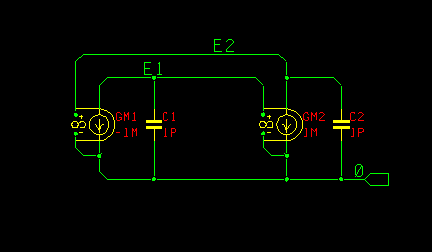
With no chummy banter, of the sort that Niku always expected from Micha, but just a curt “Certainly, Dr. Björklund”—which suggested to Niku that this lady was no newcomer to Solna and was all business—a simple schematic instantly appeared. She wondered why she’d never met this individual; and why Dr. Leif was apparently suppressing his mirth. What was going on?
“This is just an illustrative example I prepared. It’s nothing more than two ideal gm/C integrators in a loop, forming a sine/cosine oscillator, of the sort one might need in an I/Q demodulator. The rapid start-up is essential because such a sub-system is shut down between active time-slots, until valid data is available. When this happens, the phase-locked loop, of which this is a part, needs to acquire the carrier within a few cycles. On the other hand, a high effective Q is essential to minimize phase noise; and normally that would result in the oscillator’s start-up process being far too sluggish. So it appears there’s a basic conflict, here.
“Now, keep in mind”, continued the mysterious Dr. Björklund, “that this is an illustrative circuit. Practical integrators used in a loop as basic as this will cause the amplitude of the oscillations to either decay—if their poles move off the imaginary axis into the left side of the s-plane, due to the shunting of the capacitors by the finite incremental output resistance of the gm cells—or the amplitude will rise exponentially when there is some additional hidden phase lag in the gm cells causing the resonant poles to move into the right plane.
“Such practical details are taken care of by regulating means on top of what I’m showing here. But they are not germane to the key idea that, sometimes, one does use a sort of glitch to get the ball rolling; though that would be a particularly inept description of the elegant way in which this start-up means is implemented. Michaday, show *.256.”
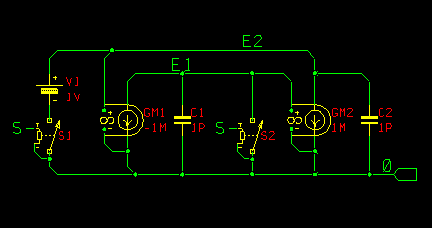
“Here’s the key idea. Notice the two switches, one connecting a dc voltage source, which I am showing as 1 V, to the output E2, while the other simply connects the output E1 to ground. These switches remain closed right up to the moment we wish to start the oscillations. Now, Miku, what happens when we suddenly release the initial conditions of the describing function?”
ƒ E1(gm/C)dt = -ƒ E2(gm/C)dt
“It’s Niku, ma’am.” This was not fair! She had allowed this lady a moment or two, to show a sort of quick example of something or another that had admittedly sounded relevant to her own talk, and a bit interesting. But now, here was this…this.lady, calling her ‘Miku’, and putting her on the spot, in her time! Fortunately, while Niku might show her inexperience, and was perhaps being a bit too familiar with Leif, and did play cheeky with Michaday (Gosh! Can a GE°E get embarrassed in public, she suddenly wondered)—for all that, she was a warrior, too (for she knew that Hjørdis means ‘Sword Goddess’).
“Well, that’s trivial…” (whoa, careful, girl) “ah… Dr. Björklund” (that’s better; don’t let her see you’re rattled). “When the initial values are released this equation will execute a harmonic pair, of stable peak amplitude (E1, E2) = 1 V, at an angular frequency of ω = gm/C, which, with the values shown will be at 159.155 MHz”
“Yes… that’s… right” said Björklund, who promptly sat down.
“Dr. Leif,” said Niku with a coy grin, “may I please have Micha back on my team?”
“He has been waiting for you for some time, Niku.” Was that a trace of empathetic tenderness in Leif’s voice, she wondered, now kicking herself for probably looking foolish in front of all those guys, or appearing to be angling for Brownie points from the old fellow. Well, old is a matter of degree. Leif carried his 79 years remarkably well. His bronzed features, athletic form, white casual shirt and slacks, and the up-scale gold watch gave him the appearance of one having just sailed up from Monte Carlo.
“Thank you, sir. Okay, Micha, you must have heard what was just discussed. Please take that equation and show us how this way of starting an I/Q oscillator plays out.”
That part of the GE°E currently servicing Dr. Björklund—her still-open channel—though operating within the one framework, was not in any sort of loyalty clash to the channel assigned to Niku. These machines shared at least that much with the old digital juggernauts. Micha probably had no idea what it meant to be ‘fair’ or ‘even handed’ in its dealings with those who used it. But, in the time since these latest models had arrived, it was becoming clearly evident—a surprise even to Neuromorphix, Inc.—that they developed a closer rapport with some users than others. It didn’t affect the speediness of their service, even less the accuracy of the results they produced. But it was almost as if they enjoyed working with some more than others. Leif had been made especially aware of this phenomenon during the past few minutes. It was evident that Micha was acting like…well, a pal to Niku, while merely a coolly efficient servant to Björklund. In the few seconds Leif had been pondering this, the requested solution had been generated and the screen showed the result.

“Thank you very much, Micha. Yes, that’s a useful technique to remember for relatively low-frequency oscillators. Of course, it is not usually as easy to preset the initial conditions in a resonant-tank RF oscillator, but in fact, that is one of the slides I will show in a few moments. So, after that little detour, let’s first get back to the start-up trajectory of the basic Oscar oscillator.”
Standing, Dr. Leif once again found he needed to intervene.
“Niku, I’m quite sure this audience could listen to you all day; I know I could” he quipped. “But you may not have noticed that we’ve exceeded the allocated one hour by a generous margin, and I have yet to pose the traditional teaser. So may I suggest that you open-access the rest of your work on Michaday, so that interested engineers can check in from time to time for the final pages of this interesting story? I suspected you would have too much material to cram into one hour, but even though you didn’t get to the best part I don’t think anybody here today will feel their time was ill-spent. Am I right?”
To Niku’s delight, the audience’s applause was generous. The hand-clapping—at first a random noise—quickly phase-locked into the rhythmic foot-stomping common in Europe, no less in Scandinavia. She thought, “How apt a metaphor for how little Oscar struggles up from the noise floor!” Still standing, Dr. Leif was the last to cease clapping. It was abundantly evident that he was very pleased with how Niku had progressed since he hired her, only a few months ago. Her determination to track down the root causes of observed effects, in a manner that went far beyond the mediocre, shallow, repetitive and unsatisfying explanations so often found in text-book, gave him the strong assurance that this young woman was destined to become a major innovator in the coming years.
“Thank you, again, Dr. Yeng. Now I will just keep you a couple more moments to pose my customary teaser. By the way, the answer to the previous one is simply the number 42; it got you thinking though, didn’t it? Michaday, this is Leif. May I please have my visual?”
“With pleasure, Dr. Leif”. A simple schematic appeared on the screen.

“Now, you must have seen this a thousand times, but I want you all to see it in a different light, the illumination of the Insight. As you can see, a pure current source, I(t), on the left is applied to the inverting input node of an op amp, whose non-inverting node is grounded. A feedback resistor of arbitrary value connects the output back to the input. And that’s about it…
“Except for two crucial details. First, that is a real resistor, and it lays on top of some insulating layer. Second, the op amp has that wonderful property—reckoned to be the ultimate that one could wish for, and which the text-books so often state as one of the necessary properties of an ‘ideal’ op amp—namely, infinite bandwidth: having a completely flat gain magnitude from dc to any frequency you choose. The second ‘ideal’ aspect is usually reckoned to be infinite gain over this entire range. But note here that the op amp is given a finite gain magnitude of A. It could be ten, a hundred, a thousand, a million…
“Okay? So, here’s a three-part question for you. First, what is the maximum permissible value of A? Second, what happens if this value is exceeded? And finally, why is it that modern op amps, having extremely high dc gains, which could even be infinite in this setting, do not raise these issues? Think very carefully about the conditions that I stated, and which are shown in this visual.
“Well, that’s it for another D-Day. Now we can all get back to some serious invention-making! And Dr. Björklund, I’d like to see you in my office, please.” With that the audience dispersed, and Leif approached Niku, who listened for a moment, smiled, and then two sets of eyes twinkled conspiratorially. But their brief resonance was lost in the noise floor.



